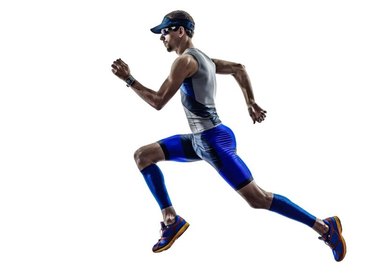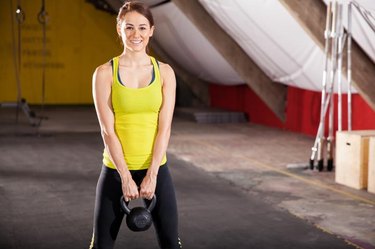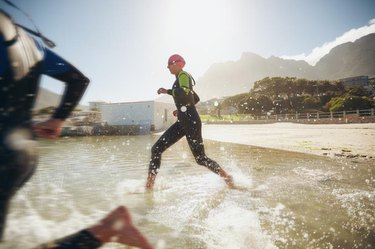
With cycling, running and swimming on your workout schedule, you think you just don't have time for strength training. However, if you want to be a successful athlete, you can't afford to skip it. Strength training keeps you healthy and builds power in those muscles you put through the ringer at every workout.
CrossFit offers a quick and dirty way to fit in strength training with fun, challenging Workouts of the Day (or WODs) and a community atmosphere. Using CrossFit to focus on strength and power, to identify muscular imbalances and to hone proper form can benefit a triathlete.
Video of the Day
Video of the Day
Read More: 17 Practical Reasons to Start Doing CrossFit
The key is to use it intelligently in your training. Commit yourself to CrossFit mainly in the off-season. Enlist the help of a trained coach, as CrossFit isn't something a triathete should do in his own garage.
Maximize CrossFit's Simplicity
One of the allures of CrossFit is its simplicity. The movements, or exercises, are based on classic strength-training — squats, deadlifts and push-ups. You do these with heavy weights and often explosively, which of course builds strength — something triathletes are often lacking.
Cycling, running and swimming for hours increases your stamina, but has its limits in building power. CrossFit movements, such as kettlebell swings and sprints, provide this missing link.
A triathlete benefits from inserting one or two 30-minute WODs in his weekly regimen. But, these workouts shouldn't focus on impressing your fellow CrossFitters. Reign in your competitive nature. Recognize your limits, your weaknesses and your priorities. You're at CrossFit to maximize triathlon training, not to win the CrossFit games.
Use CrossFit to Build Function
To benefit your sport, focus on the mechanics of each movement. A certified CrossFit coach can help you determine if you're knees are bowing out during a squat, for example, which points to weak inner thighs and outer hips. Weakness in these muscles affects your run and cycling mechanics, and can lead to injury overtime as well as impede your performance.

A push-up done with a sagging back and too-wide of arms shows that you need to work on core strength, which benefits all three disciplines, and shoulder stability for swimming.
These imbalances become especially noticeable when you lift at the level and intensity you do in a WOD. Your coach should then help tailor the WODs to address these weaknesses. You should have a why behind each CrossFit session; don't just beat yourself up because everyone else is.
Build Power in the Off-Season
CrossFit's functional moves, such as burpees, pull-ups, 400-meter sprints and kettlebell swings, can build your ability to push your speed and power on the run and bike.
But, use CrossFit primarily during the off-season, which for most people in North America is the fall and winter. CrossFit doesn't replace your need to swim, bike and run; it augments it. In the fall and winter, you spend less time outside on your bike or the trail. Two- to three-hour runs and rides don't need to be done year-round, but only build leading up to an event. So, in the off season race-specific prep workouts can be replaced with the power-building possible with CrossFit.

But, when race season is approaching, it's important to specify your workouts to your triathlon goals. Your CrossFit workouts might fall off to just once per week, if you do them at all.
Also, the high-intensity nature of CrossFit puts you at a greater risk of injury, something you definitely don't want when you have a big event looming. CrossFit can also leave you pretty sore in the day or two after a session. This could impede race specific training, so again, keep these CrossFit workouts to a minimum when you have an event on the horizon.
Read More: The 10 Most Common CrossFit Mistakes